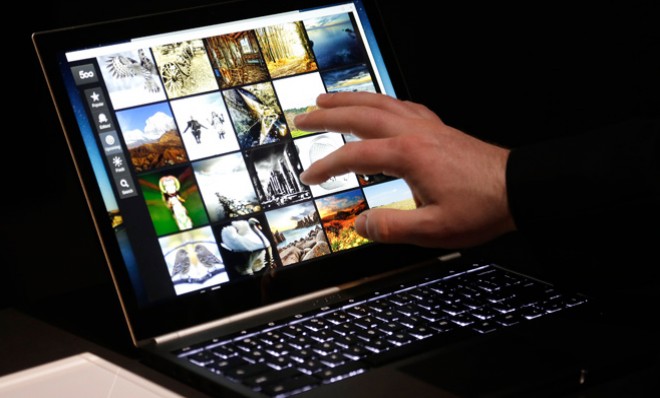Google's Chromebook Pixel: Beautiful, powerful, and too expensive
Let's face it: $1,450 for a web-browsing machine is too much to ask

Google both wowed and confused everyone when it unveiled its first-ever laptop a few days ago: The Chromebook Pixel. Like all Chromebooks it runs one program — Google's Chrome web browser. But unlike competitors like Samsung's budget-friendly $250 machine, the Pixel comes with all the trappings of a supercharged notebook: An Intel Core i5 CPU, integrated HD graphics, 4GB of RAM, 4G LTE, and most luxuriously, a super-dense high-definition display that responds to touch. All yours for the not-so-low price of $1,450.
Some see the Pixel as a halo product meant to spike interest in the Chrome ecosystem. Others, including me, believe you ought to save your money. Here's a sampling of what tech critics are saying about the Pixel:
David Pierce at The Verge says its screen is truly something to behold:
The Week
Escape your echo chamber. Get the facts behind the news, plus analysis from multiple perspectives.

Sign up for The Week's Free Newsletters
From our morning news briefing to a weekly Good News Newsletter, get the best of The Week delivered directly to your inbox.
From our morning news briefing to a weekly Good News Newsletter, get the best of The Week delivered directly to your inbox.
The Pixel's screen is the best laptop display I've ever seen. Its only rival is the Retina MacBook Pro, and it really doesn't matter which is better — the upshot is this 2560 x 1700 display is astonishingly sharp, bright, accurate, and vivid. When I lie on my bed with my MacBook Air on my chest, watching a movie or reading, I can make out individual pixels pretty easily; even with my eyes three inches away from the Pixel's screen text still looks perfect. [The Verge]
Danny Sullivan at CNET argues that the display's inability to scale to different sizes is limiting:
Want to sacrifice some image quality on a Chromebook Pixel to gain more display workspace? Sorry, no can do. Incredibly, there's no option for changing the display resolution on the machine, as with [a] Mac. You're stuck with a 1,280 x 850 display resolution, a stat you won't discover on the Chromebook site itself. [CNET]
Tim Stevens at Engadget loves the Pixel's tactility, but says the battery life stinks:
The primary keys float in a slightly recessed area, comfortably sized and comfortably spaced. Each has great feel and great resistance. Typing on this machine is a joy. ...
When it comes to battery life, Google estimates the 59Wh battery will provide "up to" five hours of continuous use. And, indeed it may. On our standard battery run-down test, which loops a video at fixed brightness, the machine clocked in at four hours and eight minutes for the WiFi model. The LTE model, with its LTE antenna on, came in about 30 minutes shorter at 3:34. These numbers are rather poor, unfortunately. [Engadget]
MG Siegler at TechCrunch doesn't see a point to the Pixel's touchscreen:
Maybe it's a case of old habits dying hard, but I basically never find myself touching the screen. Honestly, I think it has more to do with the fact that it's sort of a pain to reach up and touch the screen when you can just manipulate the on-screen elements using the trackpad where your hands already lay.
What's weird is that as an addicted iPad user, I have found myself from time to time trying to touch the screen on my MacBook. Maybe I've shamed myself enough times to have learned my lesson. Or maybe I'm just not used to manipulating Chrome this way (I still prefer Safari on my iPad). Either way, I find it odd that I’m not more drawn to touching the screen. I keep forgetting about it. [TechCrunch]
Nathan Olivarez-Giles at Wired wishes Pixel could do more than browse the web:
A free daily email with the biggest news stories of the day – and the best features from TheWeek.com
The web can't be expected to do any heavy lifting. I do occasionally edit video and work on design-heavy projects, so I have a need for things like Adobe's Creative Suite, Avid, and Final Cut Pro — apps for which there are no true web-based alternatives. This likely won't change for at least a few years, if ever.
Until then, the Pixel is a lot like a Lamborghini, a Rolex watch, or a pair of high-priced Air Jordans. It's cutting-edge, expensive, and beautiful, but it's a luxury item. It's priced high enough that few will be able to justify taking the plunge. Those who do, however, likely won't be disappointed. [Wired]
-
 Political cartoons for December 7
Political cartoons for December 7Cartoons Sunday’s political cartoons include the Trump-tanic, AI Santa, and the search for a moderate Republican
-
 Trump’s poll collapse: can he stop the slide?
Trump’s poll collapse: can he stop the slide?Talking Point President who promised to ease cost-of-living has found that US economic woes can’t be solved ‘via executive fiat’
-
 Codeword: December 7, 2025
Codeword: December 7, 2025The daily codeword puzzle from The Week